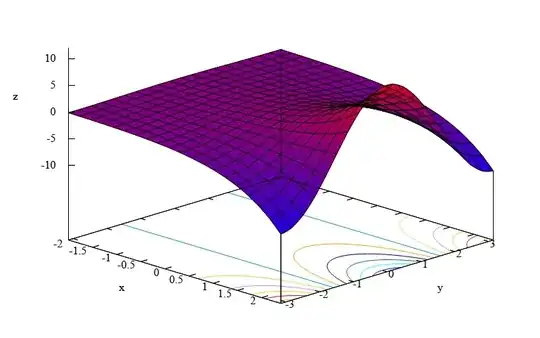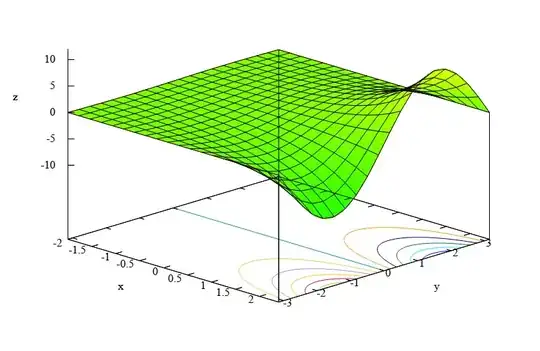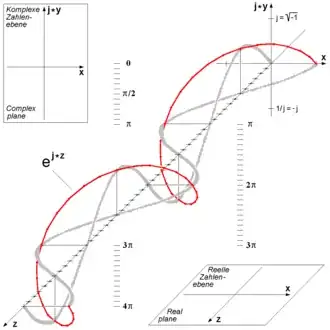I don't like my old answer. New answer:
What does $e^{x + iy}$ (where $i^2 = -1$) mean?
Well, if it is to behave in the complex numbers the same way it does in the real numbers we know:
$e^{x+iy} = e^x*e^{iy}$.
So what does $e^{iy}$ mean. Well, if it is to behave in the complex numbers the same way it does in the real numbers we know:
if $f(y) = e^{yi}$ then $f'(y) = ie^{yi}$ and $f''(y) = i^2e^{yi} = - e^{yi}$ and $f'''(y) = -ie^{yi}$ and $f''''(y) = e^{yi}$.
So if $f(y) =e^{yi} = c(y) + i*s(y)$ for some functions $c(y), s(y)$ then
$f'(y) = c'(y) + i*s'(y) = -s(y) + i*c(y) = i*f(y)$
$f''(y) = -s'(y) + i*c'(y) = -c(y) - i*s(y)=-f(y)$.
What two sets of of functions are so that $c'(y) = -s(y)$ and $s'(y)=c(y)$? And further more we need $1=e^{0i} = c(0) + i*s(0)$ so $c(0) = 1$ and $s(0) = 0$ Well... the only such functions are $s(y) = \sin(y)$ and $c(y) = \cos(y)$.
So.... $e^{x+iy} = e^x(\cos y + i \sin y)$.
So .... $e^{\pi i} = e^0(\cos \pi + i \sin \pi) = 1(-1 + 0) = -1$.
==== old answer ====
It gets abstract.
If we define $b^k = b*b*.....*b$ for positive integer $k$ and $b > 0$ we notice the fundamental:
$b^{k+j} = b^kb^j$
For that we can extend $k$ to zero and negative integers so that $b^0 = 0$ and $b^{-|k|} = \frac 1{b^{|k|}}$ and to the rational numbers via $b^{\frac mn} = (\sqrt[n]{b})^m$ even though "multiplying $b$ by iteslf $-\frac 53$ times" doesn't actually make sense.
When we learn calculus we discover if we extend this to real numbers by taking limits, we get $\frac {de^x}{dx} = e^x$ [because $\lim \frac {b^{x + h} - b^x}{h} = \lim \frac {b^x(b^h - 1)}{h} = b^x\lim \frac{b^h -1}h$ and $e$ is, one way or another, defined-- or proven to be-- the positive real value where $\lim \frac{e^h - 1}{h}= 1$] and we use this to create to recreate the definition of continuous growth.
So all is fine until we get to trying to do Complex Analysis, where we have complex numbers $z = x + xi$ where $x$ and $y$ are real numbers but $i$ is an "imaginary" number so that $i^2 = - 1$.
Slight Diversion. The most fundamental aspect of Complex Analysis and doing calculus and finding derivatives of continuous complex functions. In a sense a complex function $f:\mathbb C \rightarrow \mathbb C$ can be thought of as a multivariate function because $f(z) = w= u+vi$ is a function on $z$ which has a 2-dimensional aspect; $(x, y) \rightarrow (u,v)$. If our function is to be differentiable in complex sense we need $f'(z) = \lim_{h\rightarrow 0} \frac {f((x+h) + iy) - f(x+iy)}{h} = \lim_{j\rightarrow 0}\frac {f(x + i(y+j)) - f(x + iy)}{ij}$. In simply, but lazy terms, to be differentiable the derivative is the same from whatever direction the limit is taken. In real terms that is just whether $h$ approaches from the "left" or negative direction, or whether $h$ approaches from the "right" or positive direction. For complex numbers we also have to include the limit coming from the real "left/right" or the complex "up/down" direction.
But if we use the fact that $i^2 = -1$ we get through a lot of complicated procedures that ingetrating with respect to $x$ is to $-i$ times integrating with respect to $y$. Or $\frac {df}{dx} = -i\frac{df}{dy}$ and furthermore that if $f(x+iy) = u + iv$ then $\frac{du}{dx}=\frac{dv}{dy}$ and $\frac {du}{dy} = -\frac {dv}{dx}$ and $f'(z) = \frac{du}{dx}+\frac{dv}{dx}i = \frac {dv}{dy} - \frac {du}{dy}i$.
Okay, that was a bit complicated. But the point is...
What can $e^{x + yi}$ possibly mean? Well, we don't know. But whatever it means we need to have $e^{x + yi} = u + vi$ so that $(e^{x+yi})' = e^{x+yi}$ and if we have the condition above $\frac{du}{dx} = u$ and $\frac{dv}{dx} = v$ but $\frac{dv}{dy} = u$ and $\frac{du}{dy} =-v$.
What possible $u,v$ will satisfy that???
Well, there's only one. $u = e^x*\cos x$ and $v = e^x*\sin x$. I'll spare you the gory details.
So.... Ta-dah: If $e^{x+iy}$ is to make any sense and to follow the laws of calculus it must be $e^{x+iy} = e^xe^{iy} = e^x(\cos x + i\sin x)$.
So... $e^{\pi i} = \cos \pi + i \sin \pi = -1$!
....
Which isn't as weird as it seems. If you have $(a+bi)(c+di) = ac + (bc+ad)i + bdi^2 = (ac -bd) + (bc+ad)i$ and graph it on an $x,y$ plane, you notice each complex number has a distance for $0$ and an angle to the x-axis. If you multiply the distances are multiplied and the angles are added! So multiplication of complex numbers is a combination of multiplying absolute values are roatating. So it isn't surprising (well, actually it's jaw-dropping astonishing) that exponentiation would involve interconnected trig functions.



